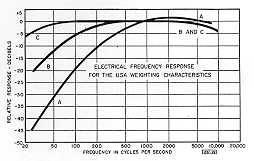Listening and Hearing
By Roger Russell
This
page is copyrighted
No portion of this site may be reproduced in whole or in part
without written permission of the author.
![]()
What's on This Page?
I worked as an engineer at the Sonotone Corporation in Elmsford, NY for eight years. Sonotone was a well-known pioneer and manufacturer of hearing aids since the late 1930's. During my stay there I learned many interesting facts about hearing, hearing damage and hearing aids.
![]()
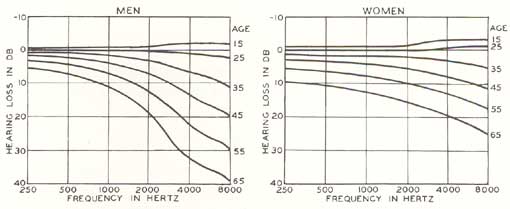 Normal hearing loss due to ageing consists of a gradual
decrease in high frequency sensitivity over time. The chart is from Modern
Sound Reproduction by Harry F. Olson. It shows the average hearing loss Vs age
for men and women at frequencies from 250 Hz to 8000 Hz. This means that for a
man at age 35, sensitivity is down about 11 dB at 8000 Hz. For a woman at that
age, sensitivity is down only about 5 dB. This varies, of course, from person
to person but we can infer that sensitivity is down even further at 20kHz.
Normal hearing loss due to ageing consists of a gradual
decrease in high frequency sensitivity over time. The chart is from Modern
Sound Reproduction by Harry F. Olson. It shows the average hearing loss Vs age
for men and women at frequencies from 250 Hz to 8000 Hz. This means that for a
man at age 35, sensitivity is down about 11 dB at 8000 Hz. For a woman at that
age, sensitivity is down only about 5 dB. This varies, of course, from person
to person but we can infer that sensitivity is down even further at 20kHz.
However, all is not lost for listening enjoyment, as you get older. There are many aspects of listening that can still be valid if you have not been exposed to excessive sound levels for long periods during your lifetime. Distortion, particularly intermodulation distortion, can still be heard through much of the frequency range. Stereo depth and spaciousness can still be perceived as well as smoothness of response in the range that has no or little loss. In fact, the only limiting factor is the inability to perceive very high frequencies, which is a small part of the overall listening scenario. Aged hearing does not normally cut off sharply but is a gradual rolloff. It means that comparisons, even at higher frequencies, can still be made to some degree. For instance, the amount of highs can be compared between two speakers but judgment cannot be made on which speaker has the most accurate highs and best overall frequency balance. Often, persons with a high frequency hearing loss will favor speakers or other equipment with exaggerated highs to compensate. Persons with hearing damage, in addition to normal loss from ageing, are more handicapped. In this case, loss can occur in bands of various widths losing up to 100% in some cases.
It is not unusual to experience distortion created by the ear mechanism. This is particularly true at the middle frequencies. Sometimes this distortion sounds like subharmonics of a tone. An example is when I attended a private concert and there was a solo opera singer. I sat about 50 away in the audience. She could sing very loud and with some notes I could hear the subharmonics in my ears. My reaction was that I didn’t think I would want to be married to this woman!
Acquired Hearing losses
Hearing loss acquired from exposure to intense sound levels and hearing loss due to age are two different things. Acquired losses can be from a variety of causes. For instance, even a relatively unobtrusive sound like driving with a window open slightly for long periods of time can bring about a cumulative and permanent hearing loss in a narrow frequency band. Of course the amount of loss depends on the intensity and length of exposure.
On the other hand, exposure to intense broadband noise, such as motorcycles or airplane engines, can cause drastic loss over a much wider range. For instance, my father flew a Spad airplane in World War I. There was no hearing protection in those days and the open cockpit was only a few feet from the exhaust ports. He developed a hearing loss that cut off sharply above 800 Hz. Although he tried hearing aids several times as they became available, the loss was so severe that no improvement was noticed. Many years later, when a loss developed below 800 Hz, a hearing aid helped to restore at least that much. The dispenser at the hearing aid center told him that that he had tested many fliers from WWI and WW2 and could even identify which plane they flew just from the audiometer tests. Some viruses can even cause total hearing loss in one or both ears and hearing may never be restorable. Acquired hearing losses this serious can make it difficult if not impossible to adequately judge the listening performance of loudspeakers or other audio equipment.
![]()
I have noticed in the past several years that sound levels at more and more places of entertainment are drastically louder. This includes such places as Disney World, Cirque de Soleil, movie theaters, nightclubs, weddings, and even cruise ship entertainment. They all involve amplified sound. I call it "Sledge Hammer Style Sound." It seems the producers do not have any restrictions for sound exposure and no warning is given to the audience in advance that they will be exposed to levels that may be unpleasant or even harmful. Unlike rock concerts, whole families are now involved. Unfortunately, the idea of louder is better has become an obsession, perhaps due to competition. Not surprisingly, this is money oriented. The loud sounds are meant to impress people and create a strong emotional experience. In some cases, this louder sound helps to keep attention to an otherwise poor performance, whether it is a movie or other entertainment. There are probably additional motivations for loud car sound—a status symbol or thought to be a way to impress a prospective mate (There must be a better way. It's hard enough for gals to get the guys to listen to them as it is).
My personal experience convinced me that short duration extra loud sounds are also dangerous. During the ride Countdown to Extinction at the Disney Animal Kingdom, there was an extremely loud slap sound. My ears were ringing after that for the rest of the day. I developed a terrible headache and felt nauseas and very fatigued. We had to leave early. I have since learned from the ASHA (American Speech-Language-Hearing Association) that "Hair cells of the inner ear and the hearing nerve can be damaged by an intense brief impulse, like an explosion, or by continuous and/or repeated exposure to noise." We received no warning that we would be exposed to dangerous sound levels that could permanently damage our hearing.
An example of this sort of hearing damage was explained in a Discovery Channel program. We all can imagine how quiet it is in the Polar Regions. It is not only quiet but extremely quiet. There are no cars, planes, lawn mowers or any other source of noise that we are used to in our daily life. We would expect hearing of the Eskimos to be excellent. Yet, for some reason, the male Eskimos were losing their hearing. It seems that for many years, seal hunting was accomplished using a spear (very quiet). However, today, rifles are used instead. It is this acoustical spike that is causing the hearing damage.
The Disney Thunder Mountain is now another threat. When it first opened, the ride was great, tunnels and all. Recently they have added a high level, high pitched screeching sound when passing through the tunnels and that did me in again. I didn’t know they had added sound for the ride. Again, we left early as the ringing and fatigue just knocked me out.
At Cirque de Soliel at Disney, I sat there with my fingers in my ears most of the time. I noticed that no one else around me was having discomfort. The sound was so loud that it shook the seat I was sitting in. It’s a shame because the performance is so unique and well done. It was ruined for me and I will never forget the punishing sound. I now warn any who plan to go to this or any other of these kinds of activities to bring adequate ear protection.
After these bad experiences, I decided to take ear plugs with me whenever there was a possibility of being exposed to loud performances. I decided to buy a sound level meter to get some numbers for what I was being exposed to. The next place I went to was Dolly Parton's Dixie Stampede. The loud sound there was not from the horses but from the public address system. It didn't take long for the sound to become very unpleasant. I put my earplugs in. I measured 85-90 dB on the A scale and slow response. On the C scale with fast response, I measured 90-100 dB. The PA system was used much of the time for about an hour. It happened that one of my foam earplugs didn't fit well in my ear. Although I thought it cut down the intensity, when I removed both of them at the end of the performance, I could only hear well out of the ear where the plug sealed best. Fortunately, this was only a temporary hearing loss and my hearing in the other ear recovered after 15 minutes or so. Again, no warning was given to us that we would be exposed to uncomfortable sound levels. To quote from ASHA, "Sounds louder than 80 decibels are considered potentially dangerous. Both the amount of noise and the length of time of exposure determine the amount of damage."
My next measurement was on the Mariner of the Sea cruise ship run by Royal Caribbean. The first show was right up there at 92-95 dBA on the slow scale. The second show was 89 dBA slow fairly often, 89 dBA slow some of the time and 92 dBA slow only occasionally. The ice show was 85 to 92 dBA slow for the music, which was most of the time. On the C scale fast, it hit 95 to 100 dB.
Dr. Phillips CineDome
Experience the world's largest Iwerks domed
theater and Digistar II planetarium, with 28,000 watts of digital sound.
Here is what I found on the page of the Orlando Science Museum. I sent an email to them asking what sound levels we would be exposed to as measured on a sound level meter. If the speakers have a sensitivity of 90 dB per watt per meter, this comes out roughly to 135 dB at 28,000watts. Obviously one speaker cannot handle all that power so there are probably multiple speakers that can increase the level even more. Increased distance from the speakers can reduce this level some but I would estimate hardly enough to keep the sound at a safe level. However, I have not measured this one so cannot confirm my suspicions.
Speaker Manual Warning
Hearing damage was even more of a concern for me when designing the new McIntosh XR speakers. When the ML speakers were being designed in 1968, the McIntosh MC2105 power amplifier was also in the design stages. That was 100 watts per channel and was a lot of power for a home amplifier at this time. I used a prototype to drive the ML's to be sure they would handle the power of this newer and bigger amplifier with no problem. The ML-4's could produce a listening level of about 106 dB at 4 feet.
When I started the new XR series, the MC2300 amplifier was available. It could deliver 300 watts per channel. That's a 5dB increase, or about 111dB for the ML-4's. For me, this was extremely loud in our 3600 cubic foot listening room. Recordings could then be played much louder than real life, which some customers seemed to prefer. Rock music at live concerts is known to reach levels of 120db or higher. A level of 120db is one acoustic watt and is at the threshold of pain. I wrote a note on the first page of the manuals for the new XR speakers that said:
CAUTION: CONTINUED EXPOSURE TO HIGH SOUND LEVELS (90 DB AND OVER
ON THE "A" SCALE SLOW RESPONSE) COULD BE DETREMENTAL TO A
PERSON'S HEARING)
Since no other company was putting warnings in their speaker manuals, It could have been misinterpreted that McIntosh speakers were harmful to hearing and thus creating negative sales. The statement was dropped by management in later system manuals.
![]()
The Emotional Appeal of Louder Sound
At home, there's nothing like listening to your favorite music on a system having good clean sound and played loud. Here, at least, you can control the listening level, but are you playing it too loud and for too long a period of time? I was still concerned with hearing damage for customers using our speakers with high power amplifiers. This is particularly true for loud listening levels in smaller rooms and listening distances of only a few feet. Headphones, earbuds and car audio are no exception for exposure. It's even tempting to turn up the volume control when wearing headphones but you can develop a hearing loss just as easily as you can from playing speakers too loud. Again, it depends on how loud you play them and the length of exposure.
Although there is a tendency to listen at louder volumes, the reasons for why people prefer this have received little attention. An excellent paper by Barry Blesser, Ph. D titled “The Seductive (Yet Destructive) Appeal of Loud Music” offers some helpful explanations. Loudness commands our attention. It’s a survival trait. Louder sounds are usually associated with danger or excitement. They make the pulse go faster. They take your attention away from other lesser stimuli. In a sense, it is like a drug, providing an escape to a different space controlled by sound like rhythm or the inventive ness of the music. The louder the sound, the more immersion there is in this other space.
People, perhaps males more than females, like bass, especially deep bass. It conveys power, strength and drama. It could convey threatening situations and decisions of fight or flight. In the movies it is used to underline the visual with impact of danger or important revelations. The louder the sound, the more emotional involvement is generated. Sound, whether it is noise or pure tones as low as 20 Hz have been observed.
Like other indulgences in life, excess exposure to intense low frequencies can be very tiring and ultimately harmful. Although the ear may be a little more tolerant at low frequencies, eventually this immediate gratification would seem to be without penalty because the gradual increase in damage is not at first apparent. Warnings are then easy to ignore and like drugs; loud sound can even be habit forming. Eventually, the truth becomes apparent and it is too late. The damage is permanent. It means that a terrible feeling of isolation can develop and communicating with others becomes a problem. You can appear to be retarded because it looks like you do not comprehend what is said to you but, in fact, the words never arrive to be recognized.
![]()
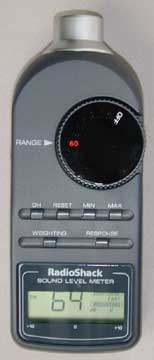 Louder is not always better. If you are concerned
about the listening levels you are hearing when playing your system (whether it
be in your car, in the home or on headphones), you can purchase an inexpensive
sound level meter and see for yourself.
Louder is not always better. If you are concerned
about the listening levels you are hearing when playing your system (whether it
be in your car, in the home or on headphones), you can purchase an inexpensive
sound level meter and see for yourself.
Three different scales are used, A, B and C, depending on level of the sound being measured. This relates to the way we hear. The digital sound level meter shown at the left is sold by Radio Shack (model number 33-2037). It sells for $59.99. A less expensive analog meter is model 33-2050 sells for $39.99. This is sufficiently accurate for home measurement. Other sound level meters for industrial use, such as those made by Bruel & Kjaer, can cost several thousand dollars.
Sound is measured using three different response curves. Curve A is used for the lowest sound levels and has the least sensitivity to low frequencies, being down almost 50 dB at 20 Hz. This decrease in low frequency sensitivity is much like the human ear, which allows us to hear higher frequencies better, even if wind is blowing in our ears. High-level sound is measured using curve C. We hear high-level sounds with almost flat response.
|
|
Set the scale to correspond to the listening level being measured. A = 24 to 55 dB |
The second factor in sound level measurement is the meter damping. The fast position gives an indication of the peak levels and the slow position gives more averaging time. Sound level measurement for noise exposure is a different criterion. Here, the A scale is used to evaluate noise exposure at high levels and the meter is set in the slow position for better averaging. Use of the response curve A implies that ear damage can be more easily caused by loud mid and high frequencies compared to the same level of low frequencies. If you were to measure the ML-4's when playing classical music and with the dBA slow reading, the sound level would be more in the order of the 90 dB range instead of 111 dB on the C scale, fast. This is because most of the energy in an orchestra is below 1 kHz where the fundamental frequencies are. The actual reading you might find will depend on the particular spectrum of the music you are playing.
 I can't imagine a rock concert without amplified
sound. Rock music and music with synthesizers usually contain stronger mid
frequency energy. Car audio levels can easily be higher and even headphones can
deliver surprisingly high levels. OSHA has specific rules for sound level
exposure. This was mainly aimed at industry and for a constant noise level, but
can just as well apply to the home. Here's a comparison of duration per day in
hours to allowable sound level in dBA, slow response.
I can't imagine a rock concert without amplified
sound. Rock music and music with synthesizers usually contain stronger mid
frequency energy. Car audio levels can easily be higher and even headphones can
deliver surprisingly high levels. OSHA has specific rules for sound level
exposure. This was mainly aimed at industry and for a constant noise level, but
can just as well apply to the home. Here's a comparison of duration per day in
hours to allowable sound level in dBA, slow response.
Hearing loss can be temporary or permanent. The extent of damage depends mainly on the intensity of the sound and the duration of the exposure. Temporary hearing loss results from short-term high-level exposure with normal hearing returning after a period of rest. Generally, prolonged exposure to high noise levels over a longer period of time gradually causes permanent damage. Unfortunately, acquired hearing loss is cumulative over your lifetime. Meanwhile, temporary or permanent tinnitus (ringing) in the ears can result.
![]()
Audio Update
Published in Electronics Now,
July 1995 "Taming the deafening decibels: Practicing "safe
sound" by Larry Klein
In last month's column, I began a discussion of the potential long term, cumulative damage to student's hearing that could result from the high sound levels present at school dances. The subject arose out of my concern, as a parent, for my son's hearing. This month, the Q-and-A format is continued, with a look at how hearing damage occurs and what other concerned parents can do to protect their children's hearing.
Q. Will the audiological screening tests given in schools pick up signs
of incipient damage?
Not necessarily. Some of the early
warning symptoms are diminished ability to differentiate between adjacent tones
and sharp dips in hearing response at narrow frequency bands. Conventional
quick screening with just five or six discreet tones to cover the frequency
bandwidth of human hearing probably will not detect such problems. High
resolution (four minutes per octave) sweep-frequency tracking audiometery and
measurement of the student's audio-frequency resolution are needed to disclose
such problems. According to the Harvard Medical School Health Letter, reduced
pitch discrimination is especially likely if the youngsters have experienced
temporary audibility-threshold shift or several minutes of ringing in their
ears after high-decibel exposure.
In a paper presented before the Audio Engineering Society, one researcher cited several audiological studies of students. In one case, it was found that 3.8% of the sixth graders failed a high-frequency hearing test, while 11% of 9th graders and 10.6% of high-school seniors failed it. A survey of incoming college freshmen yielded a 33% failure rate. The next year, 60.7% of the new incoming class failed. Those figures clearly imply an accumulation of damage.
Q. How does excessively loud sound cause hearing loss?
The injury from exposure to high sound levels takes place in the coiled,
snail-shell-shaped structure in the inner ear called the cochlea. The
fluid-filled cochlea is the final destination of the acoustic vibrations
(sound, that is) forwarded via the eardrum and the tiny bones in the inner ear.
Minute hair cells within the cochlea convert the acoustic vibrations into
microvolt electrical signals that travel through the auditory nerve to the
brain, where it is perceived as sound. Hair cells that have been exposed to
excessive sound levels become twisted, bent and/or fused and are no longer able
to respond properly to the incoming sonic vibrations. The ear's performance is
degraded even when only a relatively small number of hair cells are damaged.
Although there has been some research into hair-cell regeneration, hair-cell
damage and the resulting hearing loss seem to be permanent.
Some basic facts about hearing might be of interest at this time. The human ear is a complex electro-mechanical-hydraulic organ that responds to a band of frequencies usually given as 20 to 20,000 Hz or so. (The higher harmonics of musical instruments are in this range.) Women, for some reason, suffer about half the age-induced hearing loss of men.
When the ear's middle and high frequency response is diminished, many of the defining sounds in speech become hard to hear, and comprehension is impaired. Some speech sounds that are higher in pitch (and softer than the vowels), such as "s," "sh," and "f," might not be perceived at all, and others such as "p" and "t," might be confused. That occurs in many older adults well before they are aware that their ear' volume sensitivity is also impaired. In other words, sounds have to be louder to be heard at the same subjective level than when the ear (and the rest of the body) was younger.
It has been suggested that both of those effects are not inevitable, but rather are the result of the cumulative effect of the high sound levels common in "civilized" societies. Individuals in isolated cultures, such as the Mabaan tribe in the Sudan or the Easter Islanders, whom have never been exposed to the sonic stresses of civilization, have been tested as having youthful hearing acuity well into old age.
Q. Rock musicians are constantly exposed to very loud sound. Why isn't
their hearing affected?
It is. A nonprofit organization called H.E.A.R. (Hearing Education and
Awareness for Rockers) was founded in 1988 to educate rock musicians and their
audiences about the casual relationship between high-decibel sound and hearing
impairment. The brainchild of Kathy Peck, a well-established musician, and
Flash Gordon, MD, the organization soon found widespread support within the
music industry. Its present membership includes musicians, physicians,
audiologists, engineers, disc jockeys and journalists. Executive director Kathy
Peck is militant on the issue of excessive sound levels because she herself
suffers from a 40% hearing loss brought on by exposure to high-volume sound
during her punk-rock performance days.
In addition to its many educational and public-service activities (including distribution of 8000 pairs of earplugs at Megadeth and Lollapalooza concerts). H.E.A.R. provides testing, counseling and medical referrals to musicians troubled with hearing loss and tinnitus. Pete Townsend, who is one of the H.E.A.R.'s strong supporters, stated at a press conference announcing the Who's reunion tour that "The real reason I haven't performed live for a long time is that I have very severe hearing damage." Many other musicians have publicly acknowledged their hearing problems, among them Joey Ramone, Jerry Harrison of the Talking Heads, Ted Nugenbt, and Jason Newstead of Metallica.
The solution for some performers is specialized earplugs that reduce the overall sound level by 15 to 18 dB without affecting the audible frequency response. Many classical musicians playing in the midst of largew orchestras have also turned to hearing protectors such as "musician's earplugs" available from several manufacturers.
Q. Do you have any recommendations for the maximum allowable sound
levels at school dances?
Several points relevant to this question have been raised in the research
literature. First, there is a great individual variation in susceptibility to
sound-induced hearing loss. In other words, a sound level that will induce
severe tinnitus or threshold shift in one person, will leave another
unaffected.
Because the OSHA-recommended 90-dB/eight-hour maximum sound-pressure level is based on average responses, it is reasonable to expect that a substantial number of persons are more sensitive than average and would benefit from lower maximum SPL's. Given that fact, it seems to me that it is best to be conservative in establishing a permissible maximum level at the disco dances. Also relevant is the fact that the OSHA recommendations are questioned by the EPA, which advocates a lower maximum of 85-dB/eight hours. The ISO standard also recommends lower sound levels for given exposure times.
I've not stressed the matter of overloud Walkmen, live heavy-metal concerts, or killer car stereos, all of which contribute to the din, and potential hearing loss. Because of the damage accumulates over time as the cochlea's hair cells are knocked out one by one, it seems a wise policy to avoid sonic excess whenever possible, or wear earplug protection whenever you absolutely must indulge. Let's try to practice safe sound.
Given all of the above, I would recommend that middle and high-school disco dances operate with a maximum SPL reading of 85 dB (A-weighting, slow response, measured eight feet in front of the speakers). Measurements should be taken throughout the evening because of the previously mentioned threshold shift that impels DJs to turn up the volume as the evening wears on. Any microphone sing-along by the DJ should be included in the measurements. For monitoring purposes, I recommend the Radio Shack SPL meter (stock No. 32-2050). It sells for $31.99, is easy to use, and is certainly accurate enough for disco sound-level monitoring.
I'm aware that the 85-dB level might be unsatisfactory for a few in the audience (and the DJ), but it is far more important that the students do not suffer temporary threshold shift or short term tinnitus (as a contributor to long-term damage) as the price of their fun. At all times try to keep the kids from clustering within five feet or so in front of the speakers, as sound intensifies considerably at close range—which is probably the reason why they are there in the first place.
We all know that kids typically need to be called three or four times before they respond. Let's all help ensure that their behavior continues to reflect normal teen perversity rather than noise-induced hearing damage.
Q. Where can I get more information on the cumulative effects of
excessive sound on hearing?
I've compiled a bibliography that lists suggested reading.
|
Bahadon, Robert S. M.D., and Barbara A. Bohne, Ph.D., "Adverse Effects of Noise on Hearing," American Family Physician, 47:5 1219-1226, April 1993. Bruel & Kjaer Instruments, Inc., Measuring Sound, 1984. Deutsch, L. J. and A. M. Richards Elementary Hearing Science, Baltimore: University Park Press, 1979. Everest, F. Alton, The Master Handbook of Acoustics, Blue Ridge Summit, PA: Tab Books, Inc. 1981 "Hearing Loss: Boom and Doom," Harvard Medical School Health Letter, 16:2: 1-4, December 1990. Klein, Larry, Audio Update: Hear today, gone tomorrow," Electronics Now, 63:12 94-95, December 1992. Raichel, Daniel R., "Recreational Deafness—How Can Audio Engineers Stem It?," Presented at the 64th convention of the Audio Engineering Society, New York City, 1979. (preprint 1535-I-6) Salatoff, Robert Thayer, M.D., D.M.A., Hearing Loss in Musicians," The American Journal of Otology, 12:2: 122-127, March 1991 |
Strome, Marshall, M.D., and David Vernick, M.D., "Hearing Loss and Hearing Aids," Harvard Medical School Health Letter, 14:6:5-8, April 1989. US Environmental Protection Agency, "Noise and its measurement" (1977) Vernick, David M., M.D., ConstanceGrzelka, and editors of Consumer Reports Books, The Hearing Loss Handbook, Yonkers: Consumer Reports Books, 1993. West, P.D. and E.F. Evans, "Early detection of hearing damage in young listeners resulting from exposure to amplified music," British Journal of Audiology, 24:2: 89-103, April 1990. Whitfield, Philip, M.D., and Stoddart D.M., M.D., Hearing, Taste and Smell: Pathways of Perception, New York: Torstar Books, 1984. Williams, Rebecca D. "Enjoy, protect the best ears of your life," FDA Consumer, 26: 25-27, May 1992. Wuest, Judith and Grace Getty, "Adolescent Hearing Behavior: A School Health Promotion Program," Journal of School Health, 62:9: 436-438, November 1992. |
![]()
How the Ear Works
From my copyrighted article in
audioXpress magazine November 2007
The idea of a mechanism that took hundreds of millions of years to develop is staggering. It was accomplished so slowly that in our lifetime, we cannot observe any changes. When the ear is seen in its present day form, the resulting construction is so complex as to be overwhelming. To make matters more complicated, medical terminology can make a somewhat simple understanding even more intimidating.
The hearing mechanism is very elaborate and the processing of information by the brain is more like a science fiction story with an ending not yet in sight. Although volumes have been written about the hearing process, perhaps a few simpler explanations may help to understand some of the intricacies of the ear and how we hear.
The brain has a sound memory center which begins accumulating sounds almost at birth, perhaps even before. In normal adults, the brain has been able to establish a library of about 400,000 sound patterns to relate to the outside world. You can play tunes any time from your mental library, even complete symphonies with all the instruments playing together. In a similar way, nerve impulses from other sense organs, such as visual images or impulses from other parts of the body, can also be stored for comparison with new sensory input.
The ear is an incredibly sensitive device. The threshold of audibility corresponds to a pressure variation of less than one billionth of one atmosphere. This is commonly referenced as 0dB sound pressure level at 1000Hz but varies with frequency. At the other extreme, +130dB is considered the threshold of pain, corresponding to a voltage ratio of more than 3,000,000 to 1 (some sources quote +120dB as the pain threshold). Even a loud noise only causes microscopic movements of the ear drum. For a high frequency sound, the motion may be only one tenth of the diameter of a hydrogen molecule. Hydrogen is in a diatomic form.
Although the ear magnifies a wide range of sound intensities, the transmitting equipment is too stiff to respond to the very weakest tones, and thus they are not heard. If the range were not limited, a person would be assailed by such sounds as their own body’s muscle contractions and bone movements.
A microphone can be called a transducer because it transforms energy from an acoustical system through a diaphragm to a mechanical system that is then converted to an electrical system. The ear functions as a biological transducer.
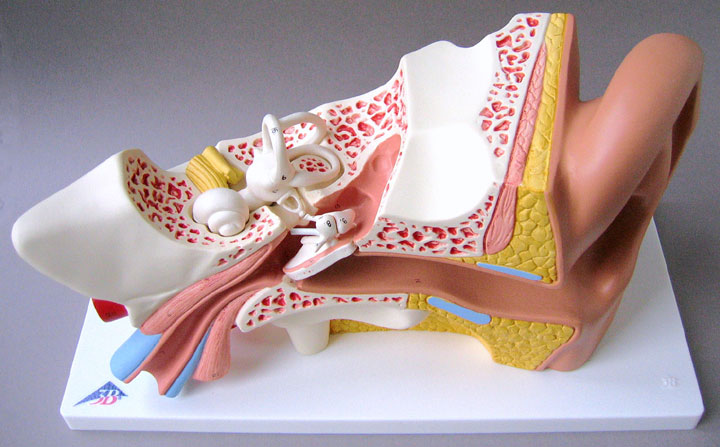
This accurate, cutaway ear model was made by 3B Scientific products, Rudorffweg 8, 21031 Hamburg, Germany. Several of the parts are removable. They are also numbered for easy identification.
There are three main sections: the outer, middle and inner ear. The outer and middle ear function as an impedance transformer, converting energy from the low impedance of the air to the high impedance of the fluid in the cochlea. Acoustic resonances in the auditory canal of the outer ear can double the sound vibration force. The mechanical advantage of the bone-lever system of the middle ear can triple it. Pressure then transmitted to the cochlea at the inner ear can increase 30 times. The total result can be an amplification of up to 180 times before a sound wave sets the fluid of the inner ear in motion.
In the above model, sound arrives at the pinna, shown at the right side, and depending on its direction travels around the various contours before entering the auditory canal at the bottom right.
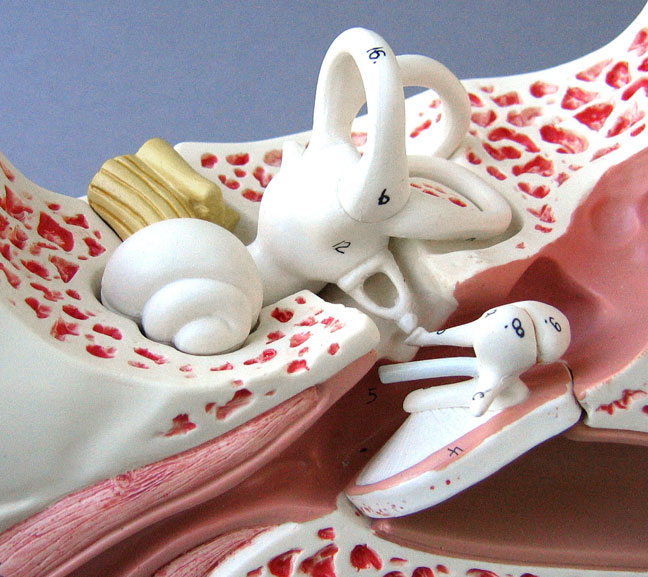
The Middle and Inner Ear
In the closeup above, the spiral-shaped cochlea shown near the left side is actually about the size of a pea. The areas flecked with red represent bone structure and you can see that the parts of the inner ear are very well protected inside the skull bone.
Sound travels from the auditory canal at the bottom right and ends at the ear drum (number 4) near the bottom right. This converts the acoustic energy to mechanical energy that is transferred from the ear drum to the mechanical system of the middle ear consisting of three bones--the hammer, anvil and stirrup (known collectively as the ossicles). These are shown just above the eardrum and are the smallest bones in the human body. The stirrup can be seen as a U-shaped bone at the center of the picture. The three loops at the top center of the picture are the semicircular canals that provide our sense of balance. They are part of the same bone structure as the spiral-shaped cochlea that can be seen at the left side. The stirrup transmits vibrations to the fluid-filled cochlea of the inner ear that converts the energy into electrical pulses that are sent to the brain. The auditory nerves are shown in yellow just above the cochlea. The eustachean tube is at the bottom left and is used to equalize air pressure on the ear drum.
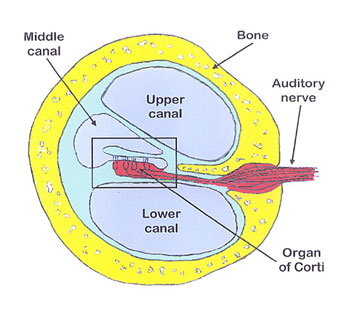 The inside of the cochlea is hollow
and is the most complex part of the hearing mechanism. A cross section is shown
at the left. It is divided into three fluid-filled parts--the tympanic (lower)
canal, the vestibular (upper) canal and the cochlear duct (middle canal). They
are separated by thin membranes. The upper and lower canals are filled with a
fluid called perilymph and the middle canal is filled with endolymph. These
fluids have different chemical compositions and electrical charge.
The inside of the cochlea is hollow
and is the most complex part of the hearing mechanism. A cross section is shown
at the left. It is divided into three fluid-filled parts--the tympanic (lower)
canal, the vestibular (upper) canal and the cochlear duct (middle canal). They
are separated by thin membranes. The upper and lower canals are filled with a
fluid called perilymph and the middle canal is filled with endolymph. These
fluids have different chemical compositions and electrical charge.
The stirrup transmits vibrations to the oval window of the upper canal. Vibrations travel through this canal to the tip of the cochlea at its center where the cross section is the smallest. The waves then enter the lower canal until they reach the membrane-covered round window at the large end of the lower canal. This window dampens the vibration.
The small rectangle enclosing the Organ of Corti is shown magnified at the right. The organ of Corti is a gelatinous mass located in the middle canal. It performs the most complex and interesting of the transformations and contains about 7,500 interrelated parts. There are 4 longitudinal rows of auditory sensor hair cells. Three of the rows are outer hair cells and one row is inner hair cells. They are embedded in supporting cells of the basilar membrane that forms the floor of the middle canal. Bundles of stiff stereocilia (much smaller hairs) project from the hair cells. Incidentally, stereocilia and stereo sound are not directly related.
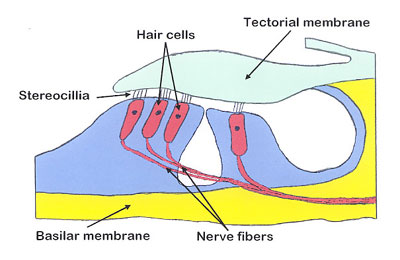 The tectorial membrane is suspended
from the bone surrounding the cochlea and projects over the hair cells and
stereocilia like a shelf. It is coupled to the organ of corti by the
stereocilia bundles attached to the hair cells. There are over a million
stereocilia in each ear. The fluid pressure waves produce motion of the basilar
membrane that bends, twists, pulls and pushes the hairs. This motion causes the
stereocilia to move against the tectorial membrane.
The tectorial membrane is suspended
from the bone surrounding the cochlea and projects over the hair cells and
stereocilia like a shelf. It is coupled to the organ of corti by the
stereocilia bundles attached to the hair cells. There are over a million
stereocilia in each ear. The fluid pressure waves produce motion of the basilar
membrane that bends, twists, pulls and pushes the hairs. This motion causes the
stereocilia to move against the tectorial membrane.
The basilar membrane is light and taut near the wider stirrup end and thick and loose at the smaller end. Waves induce a ripple in the membrane. High tones create their greatest crests where the membrane is tight, lower tones crest where the membrane is slack. The membrane can also pick up vibrations from the skull. When hearing is impaired, a bone conduction transmitter can sometimes be used to couple audio vibrations to the skull and restore partial hearing.
The chain of events for hearing then becomes even more involved with the conversion to electrical signals. The most intricate process occurs when motion of the stereocillia causes a chemical process to take place that alters the permeability of the membranes of the hair cells and allows positive ions to enter the corresponding cells. As a result, the respective cells develop a receptor potential and release more neurotransmitter molecules at its synapse with a sensory neuron. The resulting increase causes electrical discharges that are generated by the nerve cells. The cochlea-to-brain transmission system contains 30,000 nerve fibers issuing from the organ of Corti. The sound frequency interpretation depends on which fibers are activated. Although there has been some correlation with nerve-firing rate and audio frequency, there is a recovery time for each nerve that limits the maximum firing rate to 1000 firings per second. This is a much lower rate than our upper limit of hearing at 20,000 Hz. Nerves can take turns and increase the effective rate to 3000 firings per second but information about most sound frequencies depends on which fibers are activated and not on the rate of firing.
Auditory nerve axons convey signals to the thalamus and cerebral cortex of the brain, where the auditory signals are interpreted as sound. Some signals are even fed back. The enormous amount of information transmitted to the brain can be selected and interpreted in an unbelievable number of ways. One that is commonly known is our ability to filter out a single conversation in a room full of people who are all talking.
The middle ear does have a first line of defense. There are built-in safety devices that serve to protect the inner ear from loud noises and large changes in ear pressure, also known as the acoustic reflex. Loud noise in excess of 80 to 85 dB triggers two sets of muscles. The Tensor (Tympanic) muscle tightens the eardrum and restricts its ability to vibrate, while the Stapedial (stirrup) muscle pulls the stirrup away from its link to the oval window in the inner ear. However, the protective system is relatively slow to act, being from 10 to 30 milliseconds for very loud sounds and up to 150 milliseconds for levels near the trigger threshold. The muscles do not respond fast enough for acoustic spikes. In addition, drinking alcoholic beverages can inhibit the acoustic reflex.
Typically, protection response is more effective for younger people. Nevertheless, the ears defense can be overcome because there is a tendency to play music even louder and damage occurs anyway. You may have noticed that as you play music louder that the sound changes. Not only is there an apparent frequency shift, but the quality of the sound also seems to change as well. This is very apparent for some people but others may not have noticed the effect at all. I attribute it to the action of the muscles of the inner ear and a listening level above 80 to 85dB.
The second safety device is the Eustachean tube, which connects the air-filled middle ear with the mouth cavity and serves as a pressure equalizer. A common experience for us is encountered when ascending or descending in an airplane.
![]()
Hearing Protection
Our history of noise exposure has changed over the past thousands of years. As hunters and gatherers, we were adapted to life in the woods and open fields and we were straining to listen at the threshold of hearing for clues of our prey or of predators. It was a matter of survival. If you couldn’t hear well, you missed important clues, not only from the intensity but being able to distinguish the identity and direction of the sound. Perhaps the loudest sounds experienced were from thunder or a large waterfall or even from other people. It may not have been until technology appeared that the average noise exposure increased. Industrial noises even in the 1800’s became significant.
Hearing loss came from manufacturing machinery, mining and logging noise. This was most significant because workers were exposed to this sound all during the working day. Today, loud sound also comes from amplified sound through loudspeakers in places of entertainment, home, cars and even Ipods with ear buds. The amount of noise exposure today is far beyond what we were evolved to deal with. However, some people were not ignorant when it came to uncomfortable industrial sound levels. It was well known by some that plugs of beeswax fitted in the ears could protect hearing. Today there are more modern devices.
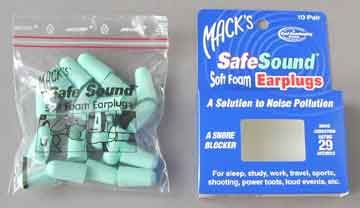 The simplest type of sound attenuation is the use of
some kind of earplugs. The simplest types are like the ones in the picture and
are available from by McKeon Products, Inc., 25460 Guenther, Warren, MI 48091.
Ten pair of these can be bought for only a couple of dollars. Drug stores
usually have a variety of earplugs.
The simplest type of sound attenuation is the use of
some kind of earplugs. The simplest types are like the ones in the picture and
are available from by McKeon Products, Inc., 25460 Guenther, Warren, MI 48091.
Ten pair of these can be bought for only a couple of dollars. Drug stores
usually have a variety of earplugs.
They are made of soft foam that can be compressed and inserted into the ear. The foam will slowly expand and fit to the contours of the ear canal. The noise reduction rating is 29 decibels. Data for attenuation is included and covers the range from 125 to 8000 hertz.
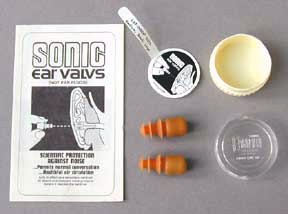 These plugs are a little more sophisticated. The ear
canal is left open to air circulation and pressure equalization but valves
close and sound filters come into play if the sound is too intense. The rear
portion has a metal container that is enclosed in the soft rubber. These rubber
cushions can be replaced with new ones without having to purchase an entire new
assembly.
These plugs are a little more sophisticated. The ear
canal is left open to air circulation and pressure equalization but valves
close and sound filters come into play if the sound is too intense. The rear
portion has a metal container that is enclosed in the soft rubber. These rubber
cushions can be replaced with new ones without having to purchase an entire new
assembly.
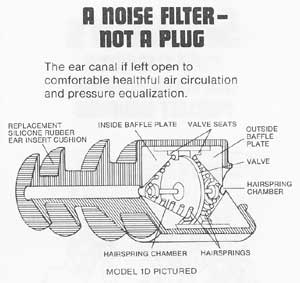 They are effective for shooting and other high
intensity sounds even if only for a short duration. Lower level sounds can
still be heard because the canal is left open.
They are effective for shooting and other high
intensity sounds even if only for a short duration. Lower level sounds can
still be heard because the canal is left open.
Sold by E.A.R., Inc.,/Insta-Mold West, PO Box 18888, Boulder, CO 80308. They are about $20.00 per pair.
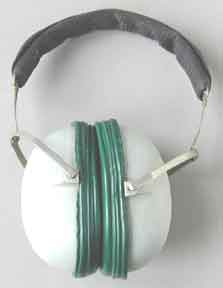 For many years sound barriers have been used. You see
them at airports and where other industrial noises occur. This particular set
is over 40 years old and is still very effective. It is made by Wilson and has
a patent number 2,801,423. The shells are made of molded fiberglass.
For many years sound barriers have been used. You see
them at airports and where other industrial noises occur. This particular set
is over 40 years old and is still very effective. It is made by Wilson and has
a patent number 2,801,423. The shells are made of molded fiberglass.
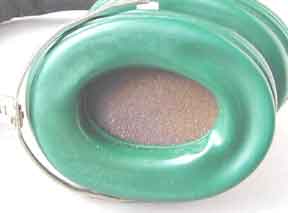 The green pads are made of soft plastic and are filled
with fluid or foam. The interior of the shell is filled with acoustic foam. The
headband acts as a spring to keep the pads tight against the ears. These are
very effective when sealed tightly. Today a variety of these are available for
home and industry.
The green pads are made of soft plastic and are filled
with fluid or foam. The interior of the shell is filled with acoustic foam. The
headband acts as a spring to keep the pads tight against the ears. These are
very effective when sealed tightly. Today a variety of these are available for
home and industry.
A more recent development is active sound barriers. A microphone picks up the external sound and a speaker inside produces this sound in reversed phase. The result is sound cancellation. Of course this sort of barrier requires the use of batteries to amplify the sound for cancellation.
![]()
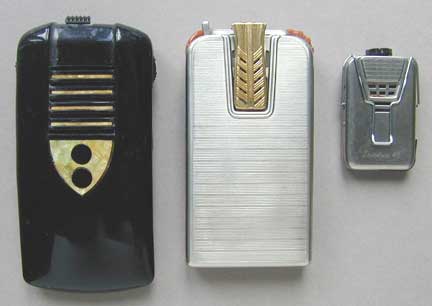 Sonotone Corporation was one of the first companies to
develop hearing aids. The first electronic hearing aids were large, heavy and used
tubes. The picture at the left shows three early model Sonotone hearing aids.
The black hearing aid at the left requires an external battery pack, which is
often in a separate container that can be worn strapped around the chest or
waist. These were made in the 1940's. The case is 5" high, 2-1/2"
wide and 1" thick and is made of Bakelite. It weighs a hefty 140 grams
(about 5 ounces). Two batteries are required. The A battery is for the tube
filaments. The B battery is for the plate voltages.
Sonotone Corporation was one of the first companies to
develop hearing aids. The first electronic hearing aids were large, heavy and used
tubes. The picture at the left shows three early model Sonotone hearing aids.
The black hearing aid at the left requires an external battery pack, which is
often in a separate container that can be worn strapped around the chest or
waist. These were made in the 1940's. The case is 5" high, 2-1/2"
wide and 1" thick and is made of Bakelite. It weighs a hefty 140 grams
(about 5 ounces). Two batteries are required. The A battery is for the tube
filaments. The B battery is for the plate voltages.
The later tube hearing aid in the center includes a battery compartment. Without the batteries, it weighs about the same as the earlier one. These hearing aids amplified a single frequency band out as far as 3-6kHz. The
The right hand hearing aid is a Sonotone 45 model and is transistorized. It requires only one low voltage battery. It measures 2-1/4" high, 1-1/2" wide and is 9/16" deep. It weighs only 36 grams (about 1.3 ounces).
 You can see that as technology advanced, hearing aids
became smaller and more efficient. More features were added as well. The
picture at the left shows three adjustments in a Sonotone 200 hearing aid.
Adjustable response became available for several smaller bands of frequencies
to enable a closer match to the areas of individual hearing losses. They can be
tailored by the hearing aid dispenser for each customer. These are tiny
switches that can be moved by a special tool and are not to be adjusted by the
customer. This method of custom adjustment is used in the McIntosh MQ104, MQ107
and MQ108 Environmental
Equalizers but in this case it's to tailor the sound in the listening room
and not compensate for hearing loss.
You can see that as technology advanced, hearing aids
became smaller and more efficient. More features were added as well. The
picture at the left shows three adjustments in a Sonotone 200 hearing aid.
Adjustable response became available for several smaller bands of frequencies
to enable a closer match to the areas of individual hearing losses. They can be
tailored by the hearing aid dispenser for each customer. These are tiny
switches that can be moved by a special tool and are not to be adjusted by the
customer. This method of custom adjustment is used in the McIntosh MQ104, MQ107
and MQ108 Environmental
Equalizers but in this case it's to tailor the sound in the listening room
and not compensate for hearing loss.
Even as early as the 1960's, smaller in-the-ear hearing aids were developed that include the battery. Today, microprocessor controlled response hearing aids are available as well as in-the-canal hearing aids.
To further augment perception, a hearing aid can be worn in each ear so that a customer can still have binaural hearing. Hearing aids can restore sensitivity to some degree out as far as 6kHz, which is more than adequate for voice recognition. The amount of restoration, of course, depends on the extent of loss and is different for each person
In hearing there are two different factors in path length difference. ITD is interaural time difference and IADS is interaural amplitude difference. The earlier arrival time at the ear nearest the source determines the sideness, left or right. The amount of ITD determines the horizontal angle.
Hearing aids might help to restore hearing to some degree depending on the severity of one’s loss. They simply amplify frequency areas where there is a hearing loss. In cases of total hearing loss, cochlear implant surgery can be performed and is becoming more popular with totally or nearly deaf people. Often, it is the stereocillia that are damaged and not the nerves. An implant can be effective in some cases and is becoming more common. A typical operation involves inserting a tiny 22-channel electrode under the basilar membrane so that it curls around inside the cochlea. The electrodes stimulate the auditory nerves, bypassing the damaged hairs. An internal receiver is added near the cochlea with an antenna loop. An external microphone and amplifier are used outside the body. The amplifier converts the audio signals to pulses and these are inductively coupled by placing the transmitting coil at the side of the head next to the receiver antenna implant. This operation can restore varying degrees of hearing but does not provide complete hearing ability. Even if it only restores partial hearing, it is a tremendous help to reduce or lessen the feeling of isolation that total or near total deafness can cause.
Here is a letter from a woman who kindly shared with me her experience after having an implant
|
Roger.
Thanks for the info. As near as I can remember my first hearing aid was either silver or beige. You would think that Sonotone would have kept a sample of each model. My last Sonotone was probably in the 90's. Then when we could not get them anymore I had to get the Danovox and then when I couldn't get that anymore had a Bosch. Had the Bosch for the last 4 years and decided I might need a new one and was trying a Starkey. I was not happy with the sound of it. So went to see Dr. Pete Smith at St. John's Mercy Hospital in St. Louis, Mo. I had met him in 1993. At that time, he told me I was a candidate for the implant but was not ready for it. So last October I went to see him and he said I was ready for it. After going thru some hearing tests and pre-op test my surgery was set for Jan. 15th of this year. I went in at 5:30a.m, had surgery a little after 7 a.m. The surgery lasts about 2 hours. I did not have any pain or did not feel any but just felt bruised. Stayed overnight at the hospital and was released at 6:30 the next morning.
Doctor took out stitches 10 days after the surgery. Then on Feb. 15th had to see doctor to check if the incision was ok and then went to St. Luke's Hospital and met an Audiologist that worked with me. She was really a great gal, She put the processor on me and set the programs on it. Couldn't believe I could hear better. It was set so that we had to wait for my nerves to get adjusted for two weeks. My problem was that I had a lot of music background that seemed to overpower what I was supposed to be hearing. They said it will take a while before it will go away. It finally went away I think during the 5th week. Then I really began to really hear.
Also, during the 5th week adjustment, I was told to pick up the phone and see if I could hear the weatherman. Couldn't believe I can hear on the phone. I am now using the phone more than my TTY phone. About 2 weeks ago I had my 3-months checkup. Had a hearing test. When I had my hearing test before I got this implant my hearing was down 90‑100.%. Couldn't hear without an aid. At my 3-month checkup my hearing was down 10‑20%. Then I had to repeat what ever words I heard in the sentences. I had 79%. Then the sentences with a swishing sound, I got 60% and then single words it was 40%. My audiologist says I did fabulous. She can't believe how fast I have come to really get this far. She was real pleased and so was I. The Cochlear Co had tested several adults with the sentences and the average was 78%.
It is really great. I am trying to not read lips too much now but listening more. The birds I can hear inside the house with the windows closed. I had never heard the clothes dryer timer ticking til I put the clothes in the dryer. Didn't know what it was at first but it was ticking before I push the button to start. Can hear when somebody is turning the water on no matter where I am at in the house. It is really great and I am glad I had it done. At least now I can hear and listen to conversations going on instead of having to have things repeated to me. Don't have to be tapped or waved to by my family to get my attention. Can also hear my grandchildren. My implant is a Cochlear Nucleus. Freedom model. The processor has 4 different programs to work with. It uses 3 #675 batteries for implants. I think if you want more info about it you can try Cochlear Nucleus Freedom. Or www.cochlear.com. Sorry this is rather long but I'm sure you can see how I really like it.
Mary V 6/12/2008 |
Here
are a few comments to a patient regarding cochlear implant candidacy from C.
Scott Frink.
President & Audiologist at Salem Audiology Clinic
Word recognition scores (or "speech discrimination"): In the past, your WRS in either ear would need to be worse than 40% (with or without a hearing aid); if either is 40% or better, most cochlea implant (CI) audiologists would not consider you to be a candidate--yet. In recent years, some ENTs have proceeded with implantation even if WRS was above 40%, but I would question their motivation. Based on the audiogram you described, I would suspect your right ear wouldn't be a candidate, but the left ear might be. If you hear well enough in the right ear, however, that would preclude implantation. Likewise, if your binaural (both ear) WRS gives you better results than either ear individually, then you need to take that into consideration as well.
How well do you do on the telephone, with or without a hearing aid? If you can do reasonably well on the phone with either ear (suspect right better than left), then you're probably not a candidate for a CI.
There are a lot of other considerations, physiological and psychological. As an example, is your overall physical health good enough to withstand a major sedation situation, bordering on brain surgery? You being only 40 years old and a long-term user, I would suspect you would be able to meet these criteria with no problem.
This all being said, I would take some time and do a lot more research before getting new hearing aids or proceeding with the CI. A CI is a modern day miracle and is an excellent solution if you meet the criteria. Once the CI is done, however, any natural residual hearing in the implanted will be gone. This is why it has, in the past, been reserved only for the most profound hearing loss, and why they usually only do one side. But if you qualify as a candidate--go for it!
![]()
Deciding on a Speaker by Listening
When it comes to speakers, test conditions are different. With an amplifier, it is easy to connect it up on a test bench and make the tests. With speakers, the environment and where they are placed in it makes a difference in how they will sound. Even the driver placement and cabinet shape is important. All together, speakers are more complex and involve three different systems. First, there is the electrical part involving resistance, inductance and capacitance. Second is the mechanical part involving mechanical resistance, compliance and mass. Third is the acoustical part involving radiation resistance, acoustic compliance and acoustic mass. Resonance, of course, can be found in any of these systems.
Does it bother you that some amplifier claims for distortion are as low as .001% or even lower? Is it a shock to find that 1% is a typical threshold for audible distortion in music and that the threshold can be even higher at some frequencies? Let us be realistic about speaker distortion. Measuring only a few spot frequencies is a waste of time. In electronics, you can measure only a few frequencies and infer that the rest of the frequencies are as low—and you will probably be right. However, when it comes to speakers, everything changes. Resonances or breakup can occur at any one or more frequencies but not at others. The only sure way is to do a continuous measurement. Alternately, a quick test can be made for serious defects using a slow sine wave sweep and listening for any audible distortion. Usually a power level of only a few watts is adequate.
A frequency response measurement for a speaker system is sometimes supplied by the manufacturer. It is usually made fairly close and directly in front of the system, right where you don’t listen. However, this single test is far from the whole story and a flat frequency response on axis or even at the listening position at home can be completely unacceptable. Response horizontally and vertically is more important. In fact, the total radiated energy from the system in all directions versus frequency is very helpful to relate to how it will sound. This can often be accomplished with the use of a reverberant room and a calibrated sound source.
Assigning a response tolerance is unreliable. For instance, a speaker that has a plus or minus 3dB tolerance can have a very smooth response within the frequency extremes or it can have a very audible 6dB peak or peaks and still be within that tolerance range. In addition, the listening room has low frequency resonances that can aid or detract from the sound, particularly below 250 Hz,
Sensitivity is also questionable. The value can depend on the frequency chosen. I have tested many different speakers over the years and invariably companies choose the frequency that has the highest output to claim in the spec sheet, sometimes even higher. I am only surprised that they do not advertise response down to DC because when you put a battery on the terminals, the woofer cone moves.
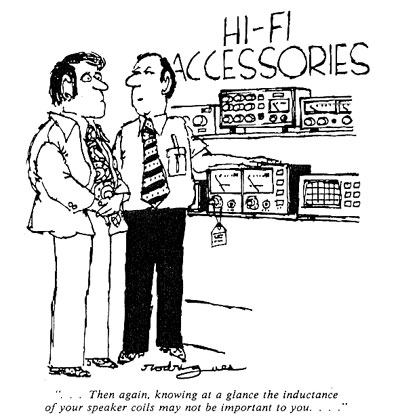
Courtesy of Rodrigues
But there is more to the story. In the final analysis, it is how the speaker sounds to you despite the results of measurements. Why is listening so important? Because it is how we hear that is important. Do you listen to sine waves or to music with your speakers? There is a difference. How good is your hearing? Ever been tested? Can you still hear 15kHz? A speaker with a response peak in the area of 15kHz could compensate for a hearing loss in that range.
Unlike many test signals and test equipment used today, the ear/brain combination responds very differently. There are reasons for this including the masking effect, loudness sensitivity and for the IDS column system even the precedence effect is important.
Masking
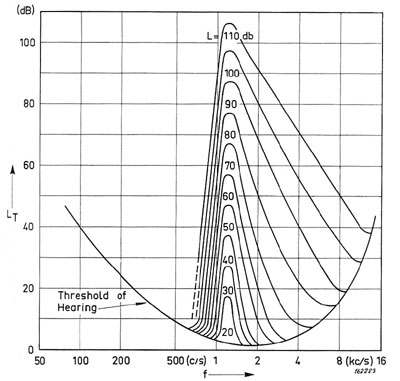
If the ear is exposed to two close frequencies at the same time and one of the sounds is very loud, the second sound is drowned out and cannot be heard. This is called Masking. The graph above shows the threshold for various sound levels at a frequency of 1200Hz. The threshold tends to follow a class III one-third octave filter but is skewed toward the upper frequencies.
Loudness
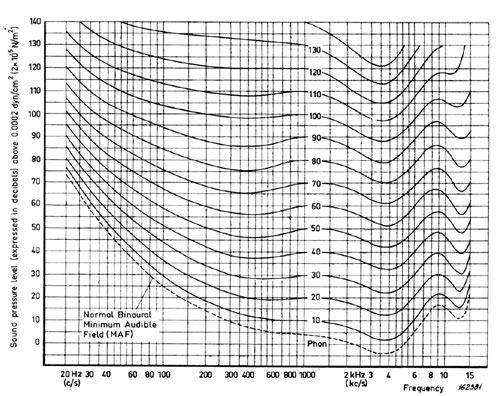
Then there is the Fletcher-Munson family of curves of perceived loudness. The ear is much less sensitive to lower frequencies at lower levels but this changes depending on the listening level.
Precedence
Then there is the precedence effect, also known as the Hass Effect .It describes the ability to correctly identify the direction of a sound source. The first sound to arrive at the ears enables you to determine the direction of the source, whether it is ahead, above or below. For the IDS system, it is the sound from the nearest part of the column that determines the apparent direction.
After hearing an initial signal, the brain will suppress any later signal, such as an echo, for a time up to about 30 or 40 milliseconds. This inhibition is called time or temporal masking. In effect, you do not hear the sound from the higher or lower drivers that would otherwise interfere with locating the nearest source of the sound. If the arrival time of any echo is longer than this, then two distinct sounds are heard, even if the second arrival is as much as10 dB higher. This is why the sound from the IDS column always appears to be coming from your listening height.
Listening
The personal experience you can trust best is by listening. Although you could judge a speaker by words and graphs, it is not being realistic. You are not going spend your time or money listening to a spec sheet. If you are interested in purchasing a speaker, any speaker, my advice is to listen to many different ones to find the one that sounds the best to you. Speakers are not perfect but some may have the qualities that you like best. Your ear/brain combination is the final test that takes priority over advertising claims and spec sheets. Don’t be fooled by price. The most expensive system is not always the best choice for your ears. Bring CDs or vinyl that you are familiar with. Bear in mind that the sound of the speakers in the store showroom will not sound exactly the same as they do in your room at home due to different room acoustics, resonances and location of the speaker in the room. However, it is a good beginning.
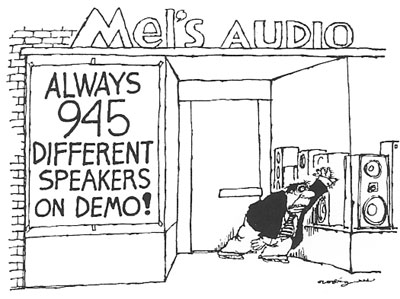
![]()
Links
Hyperacusis is defined as a collapsed tolerance to normal
environmental sounds.
Ears also lose most of their dynamic
range.
|
About This Site |
||
|
|
More text and pictures about listening and hearing will be added as my research continues. Any comments, corrections, or additions are welcome. |
|
|
|
All
contents are copyrighted |
|
